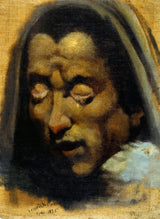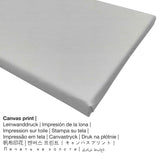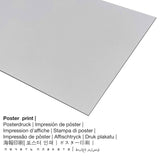Henrijs Fuseli, 1778. gads - nolādētās dvēseles vadītājs no Dantesferno (verso) - tēlotājmāksla
PVN iekļauts. Piegāde aprēķināta Pie izrakstīšanās
Šis šedevrs ar nosaukumu Head of a Damned Soul from Dante'sInferno,(verso) izgatavoja vīrietis Swiss mākslinieks Henry Fuseli. 240 gadu vecajai mākslas darba versijai bija izmērs: edges irregular, appro×, 40,6 × 29,8 cm (16 × 11 3/4 in) un tika nokrāsots ar eļļa uz audekla. "Heinrich Fuessly / 1741-1825 (verso, lower left)" was the artpiece's original inscription. The work of art can be viewed in in the Čikāgas Mākslas institūts kolekcija. Ar pieklājību no Čikāgas Mākslas institūts (licence - publisks īpašums). : Leonora zāles Gurlijas piemiņas kolekcija. Digitālās reprodukcijas izlīdzināšana notiek portretā formāts ar sānu attiecību 1: 1.4, kas nozīmē, ka garums ir par 29% īsāks nekā platums. Henry Fuseli was a male poet, illustrator, painter, drawer of Swiss nationality, whose style was mainly Romanticism. The European artist lived for a total of 84 years - born in the year 1741 in Zurich, Zurich, Switzerland and died in 1825.
Kurš būtu jūsu iecienītākais mākslas drukas materiāls?
Produktu nolaižamajos sarakstos varat izvēlēties savu individuālo izmēru un materiālu. Mēs ļaujam jums izvēlēties savu iecienītāko izmēru un materiālu no tālāk norādītajām produktu individualizācijas iespējām:
- Audekla druka: The canvas print is a printed cotton canvas mounted on a wooden stretcher. It makes a exclusive impression of three-dimensionality. The advantage of canvas prints is that they are relatively low in weight, which means that it is quite simple to hang up your Canvas print without extra wall-mounts. A canvas print is suited for any type of wall.
- Akrila stikla apdruka: The print on acrylic glass, which is often labelled as a print on plexiglass, makes your favorite original artwork into lovely wall décor. Besides, it forms a good alternative to dibond and canvas fine art prints. The artwork is printed with state-of-the-art UV direct printing technology. The major advantage of a plexiglass fine art print is that contrasts and also granular details will be identifiable with the help of the very fine tonal gradation of the picture.
- Alumīnija dibonds (metāla apdruka): An Aluminium Dibond print is a print with an impressive depth effect. The Aluminium Dibond Print is your perfect start to fine art reproductions with aluminum. For your Direct Print On Aluminum Dibond, we print the chosen artwork right on the aluminium composite surface. The colors are luminous in the highest definition, the details of the print appear clear and crisp, and you can really perceive a matte appearance. The direct print on aluminium is the most popular entry-level product and is a contemporary way to display art prints, because it puts all of the viewer’s attention on the whole artwork.
- Plakāta druka (audekla materiāls): Our poster is a UV printed canvas paper with a slightly roughened texture on the surface, that reminds the original version of the masterpiece. Please note, that depending on the size of the poster we add a white margin of approximately 2-6cm round about the work of art, which facilitates the framing with your custom frame.
Svarīga piezīme: We try our best in order to depict the art products as precisely as possible and to showcase them visually on the product detail pages. Please keep in mind that the pigments of the print materials, as well as the print result might vary marginally from the representation on your device's monitor. Depending on your screen settings and the nature of the surface, colors can unfortunately not be printed one hundret percent realistically. Given that our art reproductions are printed and processed manually, there might also be minor variations in the exact position and the size of the motif.
produkts
| Produkta veids: | tēlotājas mākslas reprodukcija |
| Reprodukcijas metode: | digitālā reproducēšana |
| Ražošanas tehnika: | digitālā druka |
| Produkta izcelsme: | Vācu ražots |
| Krājumu veids: | pēc pieprasījuma ražošanu |
| Produkta lietošana: | sienas māksla, mājas dizains |
| Orientācija: | portreta formāts |
| Attēla malu attiecība: | 1: 1.4 - garums, platums |
| Attiecība uz malu attiecību: | garums ir par 29% īsāks nekā platums |
| Pieejamie reprodukcijas materiāli: | audekla apdruka, plakāta druka (audekla papīrs), akrila stikla apdruka (ar īsta stikla pārklājumu), metāla apdruka (alumīnija dibons) |
| Audekla drukas (audekls uz nestuvju rāmja) izmēri: | 50x70cm - 20x28 ", 100x140cm - 39x55" |
| Akrila stikla apdrukas (ar īstu stikla pārklājumu) iespējas: | 50x70cm - 20x28 ", 100x140cm - 39x55" |
| Plakātu drukas (audekla papīrs) varianti: | 50x70cm - 20x28 " |
| Dibond print (alumnija materiāla) iespējas: | 50x70cm - 20x28 ", 100x140cm - 39x55" |
| Rāmis: | Bez rāmja |
Pamatinformācija par unikālo priekšmetu
| Gleznas nosaukums: | "Head of a Damned Soul from Dante'sInferno,(verso)" |
| Klasifikācija: | glezna |
| Kategorija: | klasiskā māksla |
| periods: | 18th gadsimts |
| Izveidošanas gads: | 1778 |
| Aptuvenais mākslas darba vecums: | vairāk nekā 240 gadus vecs |
| Sākotnējā vide: | eļļa uz audekla |
| Oriģinālie izmēri (mākslas darbs): | edges irregular, appro×, 40,6 × 29,8 cm (16 × 11 3/4 in) |
| Paraksts uz mākslas darbu: | heinrich Fuessly / 1741-1825 (verso, lower left) |
| Muzejs / vieta: | Čikāgas Mākslas institūts |
| Muzeja atrašanās vieta: | Čikāga, Ilinoisa, Amerikas Savienotās Valstis |
| Muzeja vietne: | www.artic.edu |
| Mākslas darba licence: | publiski |
| Pieklājīgi no: | Čikāgas Mākslas institūts |
| Mākslas darba kredītlīnija: | Leonora zāles Gurlijas piemiņas kolekcija |
Informācija par mākslinieku
| Mākslinieka vārds: | Henry Fuseli |
| Citi vārdi: | Fussly Henry the Younger, Fuseli, Fusile, Fussli Johann Heinrich the Younger, H. Fuseli, fuessli j. h., Fuseli Jean-Henri, Fuseli Henri, Fusely, Fuselli, Fuseli R.A., Fusely Henry, Fuzelli, h. fussli, h. fuessli, fuseli h., H. Fuseli Esq.R.A., Fussli Henry the Younger, [Henry Fuseli], heinrich fussli der altere, Henry Füssli, Fuseli Johann Heinrich, Fuessli Johann Heinrich, Fuseli Henry, Henry Fuseli, Fuseli Johann Heinrich the Younger, heinrich fuessli, Fuseli John Henry, Fuseli R. A., Johann Heinrich Fueßli, Fuseli Henry the Younger, Fuzeli Johann Heinrich, Fuzeli, j. h. fussli, Fi︠u︡zeli Genry, joh. heinrich fussli, Fusslin Henry the Younger, heinrich fussli, Hen Fuseli, Füssli Joh. Heinr., Füssli Heinrich II, Fusslin Johann Heinrich the Younger, Johann Heinrich Füssli, Füssli Heinrich, Johann Heinrich Fuseli, Füssli Johann Heinrich, heinrich fussli der jungere, Fuzelli Johann Heinrich, H. Fuseli R.A., Henry Fuseli Esq., Fuselli Johann Heinrich, Fuseli R.A., Hen. Fuseli, Füessli Henry, Fussly Johann Heinrich the Younger, Henry Fuseli R. A. |
| Mākslinieka dzimums: | vīrietis |
| Mākslinieka tautība: | Swiss |
| Mākslinieka darbi: | poet, drawer, illustrator, painter |
| Izcelsmes valsts: | Šveice |
| Mākslinieka klasifikācija: | vecmeistars |
| stili: | Romantisms |
| Mūžs: | 84 gadiem |
| Dzimšanas gads: | 1741 |
| Dzimtā vieta: | Cīrihe, Cīrihe, Šveice |
| Miris: | 1825 |
| Nāves pilsēta: | Putnija, Londona, Lielā Londona, Anglija, Lielbritānija, apkārtne |
© Autortiesības | www.artprinta.com (Artprinta)
(© Autortiesības - Čikāgas Mākslas institūts - www.artic.edu)
Born into a family of artists in Zurich, Henry Fuseli lived in Italy from 1770 to 1778. He probably painted this head, as well as the one executed with equally loose brushwork on the reverse of the canvas, as a study for his own use. Both images were also engraved as illustrations for Johann Caspar Lavater’s influential book on physiognomy (the science of facial structure). According to the text, the heads were inspired by damned souls in Dante Alighieri’s epic poem Inferno. Throughout his career, Fuseli favored heroic subjects taken from the work of Dante, John Milton, and William Shakespeare, and he drew formal inspiration from Michelangelo, whom he equated with his literary heroes.














